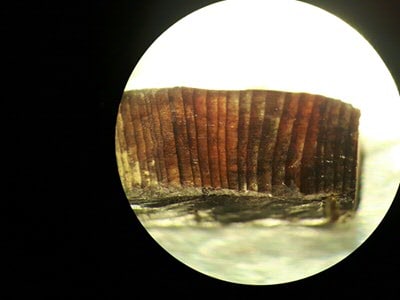
It was already known that the Normans arrived on the American continent before Columbus. But now we also know better when.
Although Christopher Columbus went down in the books as the discoverer of America, that honor actually belongs to the Vikings. It is known that they sailed to North America centuries earlier. When exactly? That was unclear. Until now. Because an international team of researchers, including scientists from the University of Groningen, have managed to set a more precise date.
The word ‘Viking’ comes from the Scandinavian term ‘vikingr’ which means ‘pirate’. It includes the people who lived in southern Norway, Denmark and Sweden. The so-called Viking Age generally refers to a period from 800 to 1050 AD. The Vikings significantly changed the political and genetic course of Europe and beyond. For example, Canute the Great – considered one of the great Viking leaders – became king of England, Leif Eriksson is said to have been the first European to reach North America and Olaf Tryggvason is said to have brought Christianity to Norway. Many expeditions involved raiding monasteries and towns along European coastal settlements. But the trade in goods such as furs, tusks and seal fat was often the more pragmatic goal.
We know that the often fiercely depicted Vikings traveled enormous distances with their iconic ships. To the west, they established settlements in Iceland and Greenland, eventually reaching L’Anse aux Meadows, located in the far north of the Canadian island of Newfoundland.
Icelandic legends
However, when they first crossed the Atlantic Ocean was unclear until recently. Earlier dates for the presence of Vikings in North America are mainly based on Icelandic sagas. However, these started out as oral tales and were only written down centuries after the events told in them took place. And so the times mentioned in these stories have been quite disputed.
Study
In a new study the researchers examined three pieces of wood, from different trees, that must have been cut down by Vikings at one time. Each piece of wood had clear cut marks and showed signs of cutting with iron blades; a material that was not produced by the indigenous people.

An examined piece of wood, seen here under a microscope. Image: University of Groningen
The researchers also looked at the growth rings and radioactive features left behind by a solar storm that occurred in 992. And as a result, the researchers were able to determine the exact year in which the Vikings were present in North America.
1021
The results show that the Normans already roamed the American continent as early as 1021 AD. And that’s interesting, since that’s exactly 1000 years ago. In addition, it is currently the earliest (and only) known year in which Europeans were present on the American continent before the arrival of Columbus in 1492. The year also represents the decisive moment when the Atlantic Ocean crossed and humans for the first time traveled all over the planet.
Viking Expeditions
Unfortunately, we do not yet know how many Viking expeditions have been to the American continent and how long they stayed there. However, there are indications that all this did not last very long. It means that the cultural and environmental legacy of these first European pioneers in North America may have been very small. Botanical evidence from L’Anse aux Meadows does suggest that the Vikings also invaded areas south of Newfoundland.
In any case, we now know that the first Europeans to set foot on the American shore were already there in 1021. The rest will have to be further investigated. For example, according to the Icelandic sagas, the encounters between the Vikings and the natives would have been sometimes violent and sometimes friendly. However, little archaeological evidence of these exchanges has been found. There are also medieval stories that indicate that important persons on the European mainland were aware that the Vikings had landed on the other side of the Atlantic. Will we ever find out about that? Time will tell.
Source material:
“Europeans already in America exactly 1000 years ago” – University of Groningen
Image at the top of this article: Barnabas Davoti via Pexels